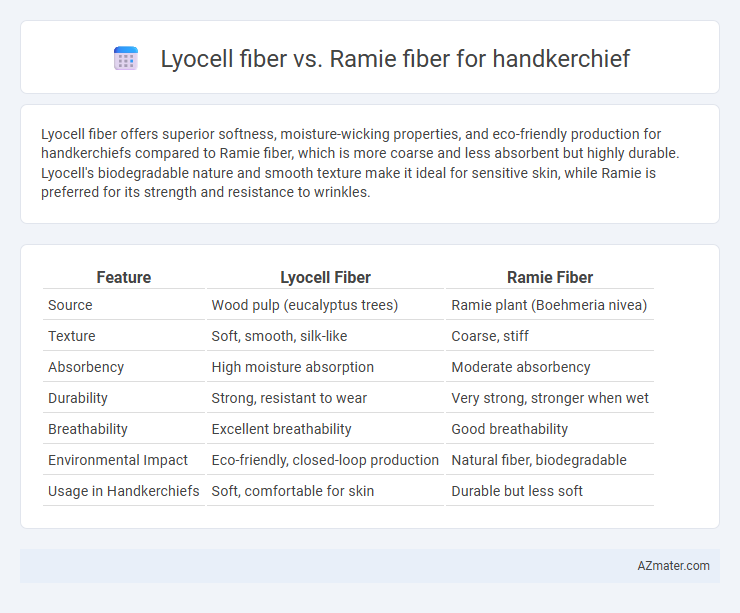Lyocell fiber offers superior softness, moisture-wicking properties, and eco-friendly production for handkerchiefs compared to Ramie fiber, which is more coarse and less absorbent but highly durable. Lyocell's biodegradable nature and smooth texture make it ideal for sensitive skin, while Ramie is preferred for its strength and resistance to wrinkles.
Table of Comparison
| Feature | Lyocell Fiber | Ramie Fiber |
|---|---|---|
| Source | Wood pulp (eucalyptus trees) | Ramie plant (Boehmeria nivea) |
| Texture | Soft, smooth, silk-like | Coarse, stiff |
| Absorbency | High moisture absorption | Moderate absorbency |
| Durability | Strong, resistant to wear | Very strong, stronger when wet |
| Breathability | Excellent breathability | Good breathability |
| Environmental Impact | Eco-friendly, closed-loop production | Natural fiber, biodegradable |
| Usage in Handkerchiefs | Soft, comfortable for skin | Durable but less soft |
Introduction to Lyocell and Ramie Fibers
Lyocell fiber is a sustainable, biodegradable fabric made from wood pulp, known for its softness, breathability, and excellent moisture-wicking properties, making it ideal for handkerchiefs. Ramie fiber, derived from the stalks of the Chinese nettle plant, offers high strength, natural luster, and resistance to bacteria and mildew, providing durability and a smooth texture. Both fibers support eco-friendly choices in textile production, with Lyocell emphasizing comfort and moisture control, while Ramie stands out for its resilience and silky feel.
Sustainability and Environmental Impact
Lyocell fiber, derived from sustainably managed eucalyptus forests using a closed-loop solvent-spinning process, offers significant environmental benefits including low water consumption and non-toxic chemical use, making it highly eco-friendly for handkerchief production. Ramie fiber, a natural bast fiber extracted from the stalks of the ramie plant, requires less pesticide and fertilizer compared to cotton but involves energy-intensive degumming processes that can impact its overall sustainability. Choosing Lyocell over Ramie for handkerchiefs enhances environmental performance through reduced chemical waste, superior biodegradability, and lower carbon footprint in manufacturing.
Source and Production Process
Lyocell fiber is derived from sustainably sourced eucalyptus wood pulp through a closed-loop solvent spinning process that recycles water and solvents, minimizing environmental impact. Ramie fiber originates from the stalks of the Chinese nettle plant, extracted by degumming that removes gummy substances to reveal strong, lustrous fibers. Lyocell's modern production emphasizes eco-friendly technology, whereas Ramie relies on traditional retting and degumming techniques rooted in agricultural practices.
Texture and Feel of Each Fiber
Lyocell fiber offers a smooth, silky texture with a soft, breathable feel ideal for handkerchiefs, enhancing comfort and moisture absorption. Ramie fiber features a coarser, more textured surface that provides durability and a slight crispness, giving handkerchiefs a traditional and robust hand. The natural luster of Lyocell contrasts with Ramie's matte finish, catering to different preferences in softness and tactile experience.
Breathability and Moisture Absorption
Lyocell fiber offers superior breathability and moisture absorption compared to ramie fiber, making it an excellent choice for handkerchiefs that require comfort and quick drying. Lyocell's fiber structure allows it to wick moisture efficiently while maintaining airflow, enhancing skin comfort. Ramie fiber, though strong and durable, tends to be less effective in moisture management, leading to slower absorption and reduced breathability.
Durability and Longevity
Lyocell fiber offers superior durability and longevity compared to ramie fiber, making it ideal for handkerchiefs due to its high tensile strength and resistance to wear and tear. Ramie fiber, while strong, tends to be more brittle and less flexible, causing faster degradation with repeated washing and use. Choosing Lyocell ensures a softer, more resilient handkerchief that maintains its quality over time.
Hypoallergenic and Skin Friendliness
Lyocell fiber exhibits superior hypoallergenic properties compared to Ramie fiber, making it an ideal choice for sensitive skin in handkerchiefs. Its smooth surface reduces irritation and is less likely to cause allergic reactions, while Ramie's coarser texture may increase the risk of skin sensitivity. The moisture-wicking capability of Lyocell further enhances skin friendliness by maintaining dryness and comfort throughout use.
Maintenance and Care Requirements
Lyocell fiber handkerchiefs require gentle washing with mild detergents and air drying to maintain softness and prevent shrinkage, benefiting from moisture-wicking and wrinkle-resistant properties. Ramie fiber handkerchiefs are more durable and tolerate frequent washing at higher temperatures, but they may become stiff and require ironing to preserve a smooth texture. Proper maintenance of Lyocell enhances its silk-like feel, while careful care of Ramie ensures long-lasting strength and a crisp appearance.
Cost Comparison for Handkerchiefs
Lyocell fiber handkerchiefs generally cost more due to the eco-friendly, energy-intensive manufacturing process and superior moisture-wicking properties compared to ramie fiber. Ramie fiber, derived from a bast plant, offers a lower price point with reasonable durability but lacks the softness and absorbency of Lyocell, making it a budget-friendly option for handkerchiefs. The price difference reflects the production complexities and fiber performance, where Lyocell commands a premium for sustainability and comfort in handkerchiefs.
Best Applications: Lyocell vs Ramie Handkerchiefs
Lyocell fibers offer superior softness, moisture-wicking properties, and durability, making them ideal for handkerchiefs used in sensitive skin applications and daily hygiene. Ramie fibers excel in their natural luster, strength, and resistance to bacteria, fitting best for decorative or luxury handkerchiefs that emphasize appearance and longevity. Both fibers provide breathability and eco-friendly advantages, but Lyocell handkerchiefs outperform in absorbency while Ramie handkerchiefs stand out in texture and durability.

Infographic: Lyocell fiber vs Ramie fiber for Handkerchief
 azmater.com
azmater.com